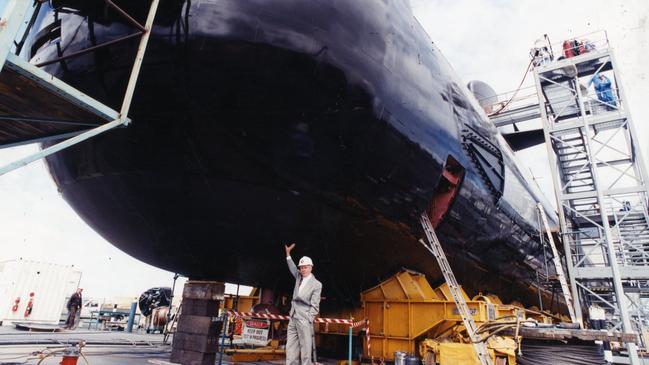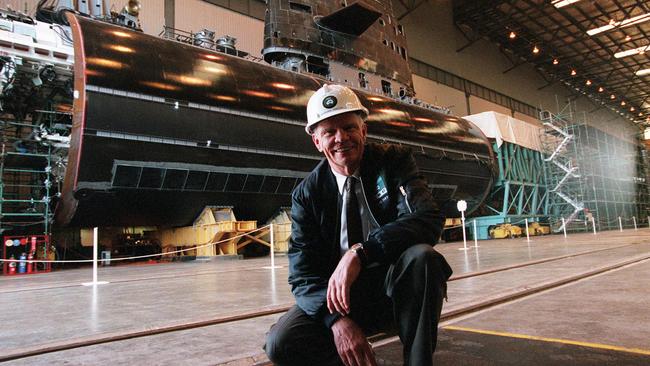AUKUS deal risks leaving us without a sub capability at all

Shifting from an ambitious delivery target for the French Attack-class submarine to an imaginary delivery date of a first nuclear-powered submarine in the mid-2040s would spell the end of the current RAN submarine squadron and any possibility of rejuvenating Australian sovereign submarine fabrication and support capacities.
Given the haphazard approach of Australian naval defence procurement, the navy’s only option is to spread its bets. That is, if government pursues the nuclear option under AUKUS and in parallel undertakes a Collins-class life extension, the defence department must also vigorously search for additional conventional submarine capabilities.
Ever since the contract was awarded in 2016 for the $90bn Attack-class submarines, the French-based Naval Group and the Department of Defence have not enjoyed a smooth relationship. As early as September 2018, the government’s Naval Shipbuilding Advisory Board suggested that alternatives should be canvassed should Naval Group’s performance not improve.
In mid-2020, confidence in the Attack-class program had been damaged to the extent that other options were under serious consideration. The Defence Strategic Update released by the Morrison government concluded that Australia’s strategic environment was deteriorating at a faster rate than identified in the 2016 defence white paper.
Yet, notwithstanding a barrage of criticism since the contract announcement in April 2016, the government’s submarine project office continued to maintain to the end that everything was on track, asserting that schedule delays of some design milestones would be easily recovered. Design of major equipment was under way, together with the site preparation adjacent to the ASC yard in Adelaide.
With the appointment of Peter Dutton as Defence Minister on March 30, Scott Morrison installed a hard-nosed minister to oversee the troubled defence department. In his first media appearance, Dutton warned Naval Group that he expected the $90bn submarine contract would be delivered on time and on budget, adding that the government would ensure Australia’s small and medium-sized defence companies benefited from the huge investments being made. And Defence Secretary Greg Moriarty stated in a Senate estimates hearing shortly after “it became clear to me that we were having challenges with the Attack-class program over the past 12 to 15 months”, and that he had held discussions with senior officers on how to resolve the issues.
Still, the accepted wisdom at the time was that walking away from the future submarine contract with Naval Group after expenditures already exceeding $2bn (plus $400m in contract cancellation fees) would destroy the defence department’s authority. Apart from creating a major diplomatic rift with France, there was also no obvious candidate for a Plan B should the contract be terminated. Naval Group had a five-year start with the design and remained “committed to delivering a truly exceptional class of new submarines, made in Australia, that will underwrite security for generations”.

But Morrison dropped a bombshell. Without first formally advising the French government of his decision to cancel the submarine contract, the Prime Minister joined Joe Biden and Boris Johnson in announcing “the creation of an enhanced trilateral security partnership called AUKUS”.
Not surprisingly, the French government feels deceived. At home, the Australian parliament and people remain uninformed about the strategic, environmental, commercial and political ramifications of a move to a nuclear submarine industry and force. It’s important to fully appreciate the issues and complexities associated with the construction, operation and maintenance of nuclear submarines powered with highly enriched weapons-grade-uranium, or HEU.
Morrison will be aware that the acquisition of HEU-235 fissile material would challenge the spirit if not the letter of the Treaty on the Non-Proliferation of Nuclear Weapons, and that the International Atomic Energy Agency requires non-nuclear weapon states declare their fissile materials for inspection. While naval nuclear propulsion is excluded from this inspection regime, the concern would be that other non-nuclear weapon states such as Iran, South Korea and Brazil may follow Australia’s lead.
Already in 2003, North Korea announced that it would no longer be bound by the treaty it signed in 1983, while Israel, India and Pakistan have desisted from signing the non-proliferation treaty in the first place.
The government and the RAN specifically will need to be satisfied that it has capacity to develop and deploy the management systems and procedures necessary to safely operate and maintain these vessels at sea and in port. In the unlikely event that the Pentagon fully supports the transfer of nuclear submarine technology to Australia, and the US congress allows the planned arrangement to proceed, it may be caveated with the proviso that the submarine propulsion train will be accessible only to US and possibly UK authorised personnel. A nuclear-safe site for a construction yard will have to be identified. State and federal governments will have to agree to the transportation, receiving and warehousing of nuclear reactors, and the installation, launching and berthing of submarines that contain HEU-235 uranium.
Equally, or even more, important, the government will have to establish procedures and develop a site in Australia to safely store several hundred tonnes of radioactive parts from decommissioned submarines. Highly enriched nuclear fuel will have to be removed for processing before the cutting up of the vessel can commence. The reactor pressure vessel, including appurtenances that are nuclear fuel contaminated, make up approximately 60 tonnes in a Virginia-class submarine. It needs to be disposed of within the most stringent regulatory framework, while low-level waste, comprising approximately 200 tonnes of equipment and platforms, pumps, pipes and fittings, needs to be disposed of in specially built underground repositories.
The arming of the RAN with nuclear attack submarines by Britain and the US in 20 or 30 years will not faze Beijing any more than the ill-conceived Attack-class program did. In the second half of the 21st century, algorithmic warfare will operate autonomous systems via artificial intelligence. China will be concerned, though, if and when Australia becomes a fully manned and armoured US garrison, with the unintentional consequences emboldening Russia, China and North Korea even further.

Morrison’s new submarine deal is, of course, much more than the loss to France and the gain for Britain of a multi-billion dollar contract; it brings to the surface once more the already fragile political relationship between the Anglosphere and Western Europe.
The deployment of nuclear boats in 20 to 30 years time won’t solve the RAN’s current predicament. Leasing nuclear submarines from the Royal Navy or US Navy seems totally unrealistic. The Life-of-Type-Extension of the Collins-class, costing some $1.2bn for each submarine, would be required to keep the six Collins-class boats in service for a decade longer than originally planned.
The refit will be more complex, more time-consuming and more expensive than the RAN expects. It will involve detailed structural examination of the hull, the likely replacement of three diesel generators, a new permanent magnetic propulsion motor, main switchgear and several kilometres of electrical cables on each submarine. The lead-acid batteries will be replaced with nickel-zinc dry cells if current testing proves to be successful. A combat system upgrade for the Collins-class is already under way. This work includes periscope upgrades, mine and obstacle avoidance systems, new flank and high-frequency intercept arrays and improved operator display functionality, and communication and a discrete satellite communication system upgrade. It will leave the navy without submarines to train submariners, let alone fight a war.
We should be pleased to see the Naval Group contract – which is neither fish nor fowl, neither nuke nor conventional submarine – cancelled, but not before a suitable replacement program is in place for the Collins-class. If the government doesn’t expedite the acquisition of new diesel-electric submarines for operational availability by the early 2030s, the RAN will no longer be a submarine navy save for a few ageing Collins boats. Sadly, though, the defence department’s poor track-record on managing major procurement programs allows for little confidence that our navy will deploy next generation submarines any time soon.
Like the 5.9 earthquake near Melbourne, the troika of Biden-Johnson-Morrison have set off a tremor that has shaken bilateral relations between centuries-old friends, the future of NATO, the EU, the ANZUS alliance, and our already fragile relationship with Beijing. While these problems will in time be painted over by diplomacy, our very own fledgling naval shipbuilding industry faces an uncertain future.
Hans-J. Ohff is the former managing director and CEO of ASC and visiting Research Fellow at the University of Adelaide.






The fundamental concern about the AUKUS military alliance does not relate to Australia obtaining nuclear-powered submarines. By the time these vessels materialise, the technology will have moved on. The last of the current Royal Navy Astute-class and the US Navy Virginia class nuclear attack submarines will be on their last voyages to the graveyard of decommissioned nuclear submarines. The primary concern for the Royal Australian Navy is the demise of its submarine force.